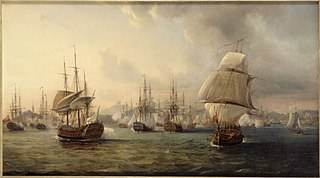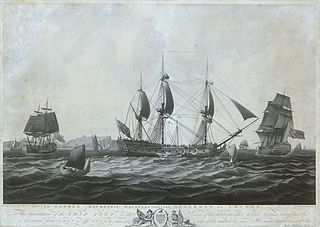HMS Sceptre was a 64-gun third-rate ship of the line of the Royal Navy, launched on 8 June 1781 at Rotherhithe.

The Battle of Porto Praya was a naval battle that took place during the American Revolutionary War on 16 April 1781 between a British squadron under Commodore George Johnstone and a French squadron under the Bailli de Suffren.

Fortitude was a merchant vessel built in 1780 on the River Thames. A French frigate captured her in 1782 while she was on the return leg of her maiden voyage to India as an East Indiaman for the British East India Company (EIC). However, the British recaptured her in October 1782. The EIC purchased her and sent her back to England. There, in 1785, George Macartney Macauley purchased her and renamed her Pitt. She then performed five voyages for the British East India Company (EIC) between 1786 and 1798. In between, she made one journey transporting convicts from England to New South Wales. She was broken up in 1801.

Earl Cornwallis was a three-decker East Indiaman launched in 1783 on the Thames. She made seven voyages for the British East India Company (EIC). Then in 1800 transported convicts from England to New South Wales. By 1809 she was no longer listed.
Exeter was a three-decker East Indiaman built by Perry and launched in 1792. She made eight voyages to the East Indies for the East India Company (EIC). More unusually, on separate voyages she captured a French frigate and participated in the Battle of Pulo Aura. She was sold for breaking up in 1811.
Royal Charlotte was launched in 1789 as an East Indiaman for the British East India Company (EIC). She made two trips to China for the EIC and on the second of these, after the outbreak of war with France in 1793, assisted at the British capture of Pondicherry. Then, the Admiralty, desirous of quickly building up the Royal Navy, purchased a number of commercial vessels, including nine East Indiamen, to meet the need for small two-decker fourth rates to serve as convoy escorts. The Admiralty purchased Royal Charlotte in 1795 and renamed her HMS Malabar. She made a trip to the West Indies where she was the lead ship of a small squadron that captured some Dutch colonies. She foundered in 1796 while escorting a convoy in the North Atlantic.

The Invasion of the Cape Colony, also known as the Battle of Muizenberg, was a British military expedition launched in 1795 against the Dutch Cape Colony at the Cape of Good Hope. The Dutch colony at the Cape, established in the seventeenth century, was at the time the only viable South African port for ships making the journey from Europe to the European colonies in the East Indies. It therefore held vital strategic importance, although it was otherwise economically insignificant. In the winter of 1794, during the French Revolutionary Wars, French troops entered the Dutch Republic, which was reformed into the Batavian Republic. In response, Great Britain launched operations against the Dutch Empire to use its facilities against the French Navy.
Osterley was a three-decker East Indiaman, launched in 1780, that made seven trips for the British East India Company between 1781 and 1800. She was present at two battles, and an engagement in which four Indiamen and a country ship engaged a French frigate. On her last trip a French frigate captured her in a single-ship action, but sent her on her way. Osterley eventually returned to Britain in 1800. Her subsequent fate is unknown.

Houghton was launched in 1782 and made six voyages as an East Indiaman for the British East India Company (EIC). In 1794 she was part of an EIC squadron that had some success against French privateers and naval vessels in the Sunda Strait, and then in 1796 she participated as a transport in the British capture of St Lucia. She was sold in 1799 and her owner took her out to India to work in the tea trade between India and China. She foundered in 1803.

Northumberland was launched in 1780 to serve as a regular ship of the British East India Company (EIC). She made six voyages for the EIC between 1780 and 1797. She was sold in 1797 for breaking up.
Brunswick was launched in 1792 as an East Indiaman for the British East India Company (EIC). She made five complete voyages for the EIC before the French captured her in 1805. Shortly thereafter she wrecked at the Cape of Good Hope.
Varuna was launched at Calcutta in 1796. She made four voyages as an "extra ship" for the British East India Company (EIC), and then spent two years as a troopship. She returned to India in 1806. She was lost in 1811, probably in a typhoon.
Britannia was launched by the Bombay Dockyard in 1772, and was rebuilt in 1778. The British East India Company (EIC) apparently acquired her in 1775. Between 1779 she made eleven complete voyages as an East Indiaman for the EIC. She also participated in three naval campaigns, during the first of which she was deployed as a cruiser off Sumatra. There she engaged and captured a French ship. In the other two served as a transport. She set out for her twelfth EIC voyage but was lost in 1805 during the third naval campaign.
In the fall of 1805 a small naval squadron under the orders of Commodore Sir Home Popham escorted a fleet of transports and East Indiamen carrying some 5000 soldiers under the command of Major-general Sir David Baird to attack the Dutch at the Cape of Good Hope. The fleet assembled at Madeira and touched at St. Salvador to replenish supplies. The expedition sailed again on the 26 November, and on 4 January 1806, in the evening, anchored to the west of Robben Island, preparatory to taking the Dutch colony.
Loyalist was launched in 1793. Between 1796 and 1803 she made four voyages for the British East India Company (EIC). She then sailed as a West Indiaman until she was condemned in 1809 as unseaworthy.

Essex was launched in 1780 as an East Indiaman. She made six voyages for the British East India Company (EIC). On her first voyage she was present at an inconclusive battle with the French, and later at a second inconclusive engagement with a French frigate. In 1798 she was sold to be hulked or broken up.
Bombay Castle was launched in 1792 as an East Indiaman. She made six voyages for the British East India Company (EIC) before she was sold in 1807 for breaking up. In addition to carrying cargo for the EIC, she transported troops in one campaign, participated in a naval action in which she helped capture a French frigate, and played a leading role in an encounter between the French Navy and a fleet of East Indiamen in which the East Indiamen succeeded in bluffing the French to withdraw.
Deptford was launched in 1781 as an East Indiaman. She made six apparently uneventful voyages for the British East India Company (EIC) before she was sold in 1807 for breaking up.
Worcester was launched in 1785 as an East Indiaman for the British East India Company (EIC). She made eight voyages to India and China for the EIC and participated as a transport in two naval expeditions before she was sold in 1809 for breaking up.
Kent was launched in Deptford in 1781. She made six voyages to India, China, and South East Asia for the British East India Company (EIC), and participated as a transport in one military campaign. She was sold for breaking up in 1797.